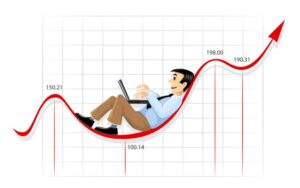February 7, 2024
 The stock market is often daunting and unpredictable, leaving even experienced investors anxious. With its constant ups and downs, it’s no surprise that many people hesitate to invest. However, as with anything in life, knowledge is power, and understanding how to navigate market volatility can help you make informed investment decisions. This is especially true for investors in Australia, where the stock market has seen its fair share of turbulence over the years. This article will discuss tips for dealing with stock market volatility in Australia, providing readers with the necessary tools to weather the storm and make intelligent investment choices.
The stock market is often daunting and unpredictable, leaving even experienced investors anxious. With its constant ups and downs, it’s no surprise that many people hesitate to invest. However, as with anything in life, knowledge is power, and understanding how to navigate market volatility can help you make informed investment decisions. This is especially true for investors in Australia, where the stock market has seen its fair share of turbulence over the years. This article will discuss tips for dealing with stock market volatility in Australia, providing readers with the necessary tools to weather the storm and make intelligent investment choices.
Do your research
The first and most crucial tip for handling stock market volatility is to do your research. Understanding the current state of the market can help you make more informed decisions about which stocks to invest in, when to buy or sell, and how much risk you can tolerate. Researching involves keeping up with news and trends affecting the market domestically and globally. This information can help you anticipate potential market moves and react accordingly.
In Australia, factors such as changes in government policies, interest rates, economic data, and global events can all influence the stock market. Staying informed and understanding how these factors affect the market is vital to mitigating risk. Therefore, reading Australian financial news outlets regularly and following reputable market analysts and economists on social media can provide valuable insights.
Another essential aspect of research is analyzing a company’s financial health before buying stocks. Look at a company’s earnings, revenue growth, debts, and cash flow to determine its stability and potential for growth. Researching a company’s competitors and industry trends can help you make more informed investment decisions.
Diversify your portfolio
Portfolio diversification is critical in managing stock market volatility. Diversification means spreading your investments across multiple stocks, industries, and asset classes, reducing the impact of market swings on your portfolio. For example, if you only invest in one industry and that sector experiences a downturn, your entire investment will suffer.
A diversified portfolio may include stocks from different finance, healthcare, and technology sectors or investments in real estate or commodities like gold. By diversifying your portfolio, you can decrease your risk exposure while potentially benefiting from market upswing. However, remember that diversification does not guarantee profits, and regularly reviewing and re-balancing your portfolio is essential.
When you buy stocks with a broker such as Saxo Bank, you can also opt for exchange-traded funds (ETFs), a basket of stocks tracking an index or sector. ETFs provide instant diversification in one investment, often costing less than buying individual stocks.
Consider long-term investing
Investing for the long term can help investors ride out market volatility. Short-term fluctuations are inevitable, but the stock market has historically shown growth over an extended period. Therefore, consider investing in stocks with a long-term view and avoid catching up in short-term market movements.
Long-term investing allows you to take advantage of compound interest, where your returns are reinvested into your portfolio, potentially increasing your profits over time. It can save you from making rash decisions during times of volatility, which can lead to losses.
You can also consider investing in exchange-traded funds (ETFs) for long-term investment. ETFs are a collection of securities that track an index, such as the S&P/ASX 200 index, providing diversification and potentially more stable returns.
Don’t let emotions guide your decisions
Various factors, including human behavior, influence the stock market. Many investors make emotional decisions during volatile times, leading to poor investment choices. Fear and panic often drive people to sell their stocks when the market is down, potentially missing out on future gains.
To avoid making decisions based on emotions, have a well-defined investment strategy. Stick to your plan and avoid reacting impulsively to market fluctuations. It helps to remember that the stock market goes through cycles of ups and downs, and staying invested for the long term can help you ride out any temporary downturns.
Consider working with a financial advisor who can provide objective advice and help you stick to your investment strategy.
Keep an eye on your investments
Regularly monitoring your portfolio is crucial to managing stock market volatility. Keep track of how your investments are performing and make adjustments as needed. Reviewing your portfolio can help you identify areas of weakness, such as underperforming stocks, and take necessary action.
However, regularly checking the market is essential to avoid becoming consumed. Set realistic expectations for your investments and avoid obsessing over short-term fluctuations. Instead, focus on the long-term growth potential of your portfolio.
Be prepared for ups and downs
No matter how well you research or diversify your portfolio, stock market volatility is inevitable. Be prepared to withstand the ups and downs of the market by diversifying your investments, having a long-term view, and managing your emotions. Understand that temporary downturns are part of the stock market cycle, and staying invested for the long haul can potentially lead to significant gains.
It’s also essential to have an emergency fund outside of your investments. It can help you avoid selling stocks at a loss during difficult times.
Tags:
Currency,
economy,
financial planning,
Foreign Exchange,
Forex,
forex trading,
investments,
money,
Stock Market
December 17, 2021
 Trading is all about risk vs reward. It is because trading without leverage increases potential rewards exponentially. Still, the same multiplier applies to losses, meaning that should the price suddenly move against you, your loss will be exponentially more significant than your profit should the price suddenly turn around in your favour.
Trading is all about risk vs reward. It is because trading without leverage increases potential rewards exponentially. Still, the same multiplier applies to losses, meaning that should the price suddenly move against you, your loss will be exponentially more significant than your profit should the price suddenly turn around in your favour.
Position trading is one of many forms of trading available and falls under the umbrella of ‘algorithmic trading’. Position traders make trades on a slower time scale than day-traders or swing traders – using indicators that give them buy/sell signals at longer intervals (orders can last for months rather than minutes).
Indicators that are used include moving averages, Ichimoku Clouds, Bollinger Bands and RSI. A typical position trade will utilize all of these indicators to give a buy signal at the lowest point in a downward trend and a sell signal when prices return to an upward trend after touching the bottom of a downward one.
Once you have your signals, you’ll need to make sure to place an order with your broker. It is where things get tricky for new traders – most brokers only accept market orders, not limit orders.
Market Orders:
A market order will execute an order at whatever price it finds on the other side of the trade – so should you put in a market buy order when RSI is giving an oversold signal. Still, someone has already put in their sell-order at the current low price; then your buy-order will be executed at this ‘market’ price, not the price you set when placing your order.
Limit Orders:
A limit order is where you set a take-profit or stop loss for your position and only execute the trade should prices reach this point. For example – if RSI is giving an oversold signal, Bollinger bands are tightly around the current price. It’s not safe to place a market buy order yet as there could be considerable downside before any upward trend begins. Instead – try putting in a limit buy order at 1% below the current market value. This way, if prices drop suddenly due to news etc., your position will only be executed once markets return to their normal range.
Common Position Trading Strategies
Traders who use position trading methods can focus on the long-term picture rather than reacting to short-term market noise. Position traders disregard minor trend fluctuations. Therefore they need strategies that are rooted in rationality and analysis.
Breakout Trading Strategy
Traders in a breakout trading strategy wait for the price line to cross a support or resistance level. When the overhead resistance is broken, the trader enters an extended position. Conversely, when the price breaks through the support line, he closes his trade. This trading technique will pay off if you are adept at detecting recurring support and resistance levels.
Pullback and Retracement Trading Strategy
The fact that traders use pullbacks to plan entry demonstrates how important they are in the market. Traders look for pullbacks in their trading techniques to guide their entry. The policy is to buy low and sell high, which means you should buy low and sell high when the price drops during a pullback. When the price drops during a pushback, traders enter the market.
Range Trading
When the price moves within periodical highs and lows, traders employ a range trading method without any apparent trend. Traders utilize price range methods to identify oversold assets to buy and overbought assets to sell.
Conclusion
Position traders rely on fundamental and technical analysis to understand the market movement. These techniques aren’t simple to follow, especially for inexperienced investors, but if you’re interested in positional trading, they’ll help you become more comfortable with your decisions.
If all of that sounds a bit complicated, then don’t worry – it is! Trading isn’t for everyone, and I’d recommend starting by reading as much material on investing as you can before making any moves. A perfect place to start learning about trading is at Saxo Bank. Check them out!
Tags:
Business,
Currency,
economy,
Exchange,
financial planning,
Foreign Exchange,
Forex,
money,
Trade,
Traders,
Trading
April 16, 2021
 People, for their nature, are in a constant quest for finding ways for making money or profiting from their capital. Due to the recent events though, this attitude has begun to be predominant for those restricted at home, and that’s how online stock trading began its unstoppable rise.
People, for their nature, are in a constant quest for finding ways for making money or profiting from their capital. Due to the recent events though, this attitude has begun to be predominant for those restricted at home, and that’s how online stock trading began its unstoppable rise.
Between the many broker firms you can find online, there are some which may be considered more trustworthy than others. Traders tend to make a difference between regulated brokers and non-regulated ones, and for a good reason: brokerage services which are not regulated by a regulator lead often to scams and money-losses.
That’s why today our focus will be addressed towards one of the most famous regulated brokers available online: eToro.
In this eToro review we’ll discuss main features related to the eToro trading platform, regulation, fees and everything you need to know before start trading with it.
eToro: Why It’s Safe
Born in 2007 as “Retail FX” in Tel Aviv, this brokering service has now reached and surpassed $800 million in value and it’s used by +10 millions people across the world.
This achievement has been reached for many reasons, and one of these is surely being a very well-regulated broker. In fact, eToro has a presence worldwide with many offices across the world and different entities for different regions, and each one of those are regulated from local and internationally recognized top-tier regulators such as CySEC, ASIC, FCA and FinCEN.
Additionally, this broker offers high protection standards for its client’s funds. We’re speaking in regards to two measures enacted by eToro: negative balance protection and segregated accounts.
While negative balance protection consists in an automatic block of the trader’s balance before it goes in red, segregated accounts are an extra-precautionary measure useful in the unlikely case of the broker’s bankruptcy. With segregated accounts, traders’ money cannot be touched by liquidators or anyone else outside of the one who made the deposit, because they’re the only one allowed to access the bank account.
eToro: Why It’s Famous
eToro has become an international phenomena for plenty of reasons, but one of the strongest has always been related to that revolutionary idea called Social Trading.
This brokerage service has implemented autonomously a proprietary trading platform which has integrated many features inspired by main social media. Once you’ve opened eToro, you’ll find that assets are treated like Facebook’s posts or tweets, with other traders discussing and arguing on the last news regarding it.
Furthermore, what really made eToro’s fortune has been the most iconic feature of all: the Copy Trading.
This innovative feature made it possible, even to the less experienced trader, to copy other traders and their portfolio in an automated way. In fact, once enabled this feature opens any position opened in the selected portfolio, and so it will be for any future position.
Those targeted by this feature are usually a part of what we’d call “Influcencers” if we were on a social platform, but here they are called Top Investors. These kinds of traders are a sort of peculiar asset and you can invest in them depending on their risk level and your profit aims.
If you are a new trader though, we strongly suggest you to pick a Top investor with a low risk ratio.
eToro: Before You Start
If you want to start trading by opening an account with eToro, you can do it by doing a minimum deposit of only $50 if you’re a US resident. If you don’t want to commit and invest money straight away, this is not the only way to start.
As a matter of fact, eToro allows you to open a free demo account. By using this form of trading, you’ll be able to practice how much you want, without fearing making mistakes that will lead you to lose money.
Tags:
Broker,
Business,
economy,
Foreign Exchange,
Forex,
investments,
money,
Trading
February 17, 2020
 If you have tried your hand at stock trading, you may know how a demat account works. When you buy equity shares, these get credited into your demat account. Similarly, when you sell those shares, they get debited from your demat account. The account functions like a savings bank account, except that instead of parking cash it stores your financial security certificates.You can open an account with a depository participant (DP) like a bank or broker. In return for the service, you will incur demat account charges.
If you have tried your hand at stock trading, you may know how a demat account works. When you buy equity shares, these get credited into your demat account. Similarly, when you sell those shares, they get debited from your demat account. The account functions like a savings bank account, except that instead of parking cash it stores your financial security certificates.You can open an account with a depository participant (DP) like a bank or broker. In return for the service, you will incur demat account charges.
Now, you know that an individual can hold multiple bank accounts. Does this option extend to demat accounts as well? The answer is ‘yes’. However, there are some conditions to bear in mind if you are planning to open a second or third demat account. Being aware of these restrictions will ensure a seamless demat account opening process.
Have questions about the implications of opening multiple demat accounts? Here are the answers to some common demat account questions:
1. Is it legal to have more than one demat account in India?
Yes, it is legal to hold more than one demat account. In fact, there are no restrictions on the number of demat accounts a person can have provided you keep paying the demat account charges.
Is there scope for confusion? Not really. That’s because each time you open a demat account, your Permanent Account Number (PAN) card serves as the unique identifier.No matter how many demat accounts you open, they will all be linked to the same PAN. All the security transactions you make through those multiple accounts will be reflected accordingly.
2. Can you open two demat accounts with the same broker?
Unfortunately,that is not possible. You cannot apply for another account with your existing broker. However, you can approach a different broker to openthe second demat account. Just ensure that the broker is registered with one of the central depositories, whether Central Depository Services Ltd(CDSL) or National Securities Depository Limited (NSDL).
3. Isit safe to keep shares in multiple demat accounts?
Your shares are secure in any demat account. Opening multiple demat accounts will not compromise their safety. In fact, you may be surprised to learn that stockbrokers have no control over demat accounts. Your shares in the demat account are held with a central depository—either CDSL or NSDL. The stockbroker is simply a depository participant (DP) acting on behalf of the depository.
4. Do multiple demat accounts need multiple trading accounts?
No, they do not. You can link your subsequent demat accounts with any existing trading account. For instance, if you engage in both trading and investing, you could maintain one demat account for stock trading and another for your investments.This would allow you to segregate your trading and investment portfolios with ease.
5. What pointers should be noted before opening multiple demat accounts?
• You will incur demat account charges for every account you hold. While some DPs waive the account opening fee, you will have to pay an annual maintenance charge (AMC) as well as transaction charges.The AMC would apply even if one of your demat accounts is lying idle.If you don’t really need the extra account, think about whether it is worth the extra demat account charges.
• It may happen that one of your demat accounts remains dormant for a certain period. In this case, the DP will freeze the account. You would have to fulfill the Know-Your-Customer (KYC) formalities all over again to reactivate the account.
• If an account is likely to be idle for a prolonged period, you could submit a freeze request to your DP. This ensures that your account cannot be misused during the dormant phase. However, corporate action benefits like dividend payments will continue to be credited to your account automatically.
• When you have multiple demat accounts, ensure that all the accounts are linked with your PAN card and Aadhaar card.
• A perk of having multiple demat accounts with multiple DPs is that you gain access to different trading platforms, products, and services. You can also gather valuable insights by accessing and comparing their research reports.
The bottom-line
As you can see, it is perfectly legal to have multiple demat accounts in India. However, you should weigh the pros and cons before applying for an additional account. While there are benefits to maintaining more than one account, you do incur extra demat account charges. Plus, you have to stay updated on all transactions across your different demat accounts by going through holdings and transaction statements with a fine-tooth comb.
Are you not happy with your current DP?Rather than open a fresh demat account, you could consider moving to another DP. For instance, to gain access to powerful trading and investment platforms, you could open an account with a tech-forward broker like Kotak Securities. Just make sure to shop around for a demat account and a DP that fits your bill of requirements.
Tags:
Accounts,
banking,
Business,
economy,
financial planning,
Forex,
investments,
money,
Trade,
Trading
December 3, 2019
 The foreign exchange market, aka forex market, is famous for its extra-ordinary facilities when it comes to buying and selling various currencies all around the globe. Just like the stocks, the main objective of forex trading is buying low and selling high. In this way, traders can yield a net profit. There is a plus point of being a forex trader. They can pick any handful of currencies which stock traders can’t usually. Currently, there is no bigger trading market in the world than the forex market. Besides, there are no higher liquid assets than forex liquid assets. However, all these facilities do not mean that there is no risk in forex trading. Just like other trading centers, forex likewise comes with some potential risks. Today, we are going to demonstrate those risks. Let’s get started.
The foreign exchange market, aka forex market, is famous for its extra-ordinary facilities when it comes to buying and selling various currencies all around the globe. Just like the stocks, the main objective of forex trading is buying low and selling high. In this way, traders can yield a net profit. There is a plus point of being a forex trader. They can pick any handful of currencies which stock traders can’t usually. Currently, there is no bigger trading market in the world than the forex market. Besides, there are no higher liquid assets than forex liquid assets. However, all these facilities do not mean that there is no risk in forex trading. Just like other trading centers, forex likewise comes with some potential risks. Today, we are going to demonstrate those risks. Let’s get started.
Exchange Rate Risk
When the value of currency changes, the exchange rate risk shows up. The volatile shifts and the demand balance are highly responsible for this type of risk. This risk is very generous and depends on the possibility of what direction the monetary standards will move.
Interest Rate Risk
Interest Rte Risk is one of the main aspects that can make the SPREAD range increased. Trading with floating spreads can be very hazardous as they keep on changing over time. The floating spreads can even go ten pips higher than the initial ASK price. This type of risk can happen at a specific time of the month, based on the participant’s country.
Credit Risk
The credit risk is an even more complex risk. But, one thing for sure is, it doesn’t have any impact on the average trader as long as he has the ability to take any side of the trade. You always need a broker to trade and a trading platform such as Q8Trade is your best option especially if you are based in Saudi Arabia, UAE, Kuwait, Bahrain and other countries in the Middle East and the North African region. Sometimes the brokers might be fraudulent, and you might end up losing your money.
Country Risk
The state of the currency is never the same in different countries. It’s optimal that you run a thorough research on the currency before even starting your trading exercises. In third world countries, the banks have to go through complications when it comes to maintaining the exchange rate. As a result, the currency gets devalued at times when the banks of the country go through any frequent deficits.
Transaction Risk
If you want to make the most out of your time, you have to make use of the value of currencies. If you don’t, the transaction risk shows up. Know the time difference between the beginning n the settling of a contract. If you want to make sure of the most value of the foreign currency, it’s optimal that you convert it to the domestic currency at the initial stage.
If you don’t stay aware of these potential risks, the chances are that you may end up losing all your hard-earned money while trading in forex. Along with the time differences, political issues can also play a great role in the forex risks. Hence, keep your eyes open and stay up-to-date while you are trading in forex.
Tags:
Business,
Currency,
Foreign Exchange,
Forex,
investments,
money,
Stocks,
Trade,
Trading
 The stock market is often daunting and unpredictable, leaving even experienced investors anxious. With its constant ups and downs, it’s no surprise that many people hesitate to invest. However, as with anything in life, knowledge is power, and understanding how to navigate market volatility can help you make informed investment decisions. This is especially true for investors in Australia, where the stock market has seen its fair share of turbulence over the years. This article will discuss tips for dealing with stock market volatility in Australia, providing readers with the necessary tools to weather the storm and make intelligent investment choices.
The stock market is often daunting and unpredictable, leaving even experienced investors anxious. With its constant ups and downs, it’s no surprise that many people hesitate to invest. However, as with anything in life, knowledge is power, and understanding how to navigate market volatility can help you make informed investment decisions. This is especially true for investors in Australia, where the stock market has seen its fair share of turbulence over the years. This article will discuss tips for dealing with stock market volatility in Australia, providing readers with the necessary tools to weather the storm and make intelligent investment choices.




Recent Comments